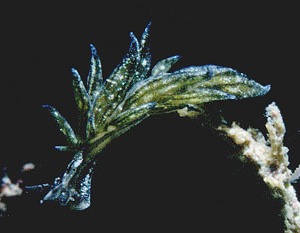

Aplysiopsis cf. formosa
Order: SACOGLOSSA
Superfamily: LIMAPONTIOIDEA
Family: Hermaeidae
PHOTO
Flinders Pier, Victoria, Australia, 3m. 9mm long. 9 April 2002. Photo: John Chuk.
"The photos look like a species of Aplysiopsis which has not at yet been described from Australia. I did make a redescription of Aplysiopsis formosa Pruvot-Fol from [specimens collected at] the Azores, and I just looked in The Southern Synthesis (p. 973), where Bob Burn claims that he found that species from central Victoria. The animals in these pictures do look very similar - though I suspect they are rather small specimens?"
Kathe Jensen
• Jensen, K.R. 1995. Anatomy and biology of Aplysiopsis formosa Pruvot-Fol (Mollusca, Opisthobranchia, Sacoglossa) from the Azores. Acoreana, Suppl. 1995:217-230.
Authorship detailsJensen, K.R., 2002 (June 20) Aplysiopsis cf. formosa [In] Sea Slug Forum. Australian Museum, Sydney. Available from http://www.seaslugforum.net/find/aplycfform
Related messages
Aplysiopsis cf. formosa from eastern Australia
November 26, 2002
From: Rachel Przeslawski
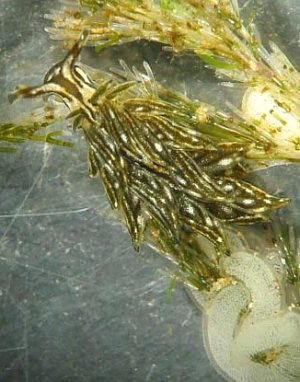
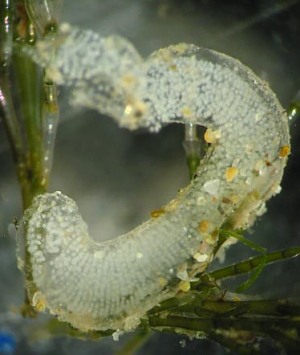
Hi Bill,
I collected these unknown egg masses on bryozoans off the Illawarra coast. [New South Wales, Australia]. When I got them back to the lab, I noticed 4 tiny, VERY well camouflaged aeolids(?) crawling among the bryozoan. I removed all the egg masses and kept the animals isolated overnight. The next morning there was another egg mass amongst the adults so this species definitely lays this egg mass.
Trouble is, I can't identify this species! The largest adults are 1cm long. They didn't shed their cerata until immersed in formalin. The egg masses have an egg-free rind with the eggs lined up in obvious circular bands. The eggs are 75um and the capsules are slightly larger at 100um.
Thanks for your help!
Rachel Przeslawski
rachelp@uow.edu.au
Przeslawski, R., 2002 (Nov 26) Aplysiopsis cf. formosa from eastern Australia. [Message in] Sea Slug Forum. Australian Museum, Sydney. Available from http://www.seaslugforum.net/find/8485Dear Rachel,
Thanks for this interesting find. Firstly the 'bryozoan' is an alga, although it does look quite like non-calcified bryozoans such as Zoobotryon and Amathia, and the slug is a sacoglossan, a group of herbivorous sea slugs, some of which look very similar to aeolid nudibranchs.
This species is quite common in southeastern Australia and has been identified with a European species Aplysiopsis formosa. The identification is probably correct, but it would be good to get the anatomy of the two compared. Also supporting the identification is its algal food. In Europe the species feeds on Cladophora prolifera, and it would appear that the southern Australian animals are also found on the same alga. I have asked Dr Allan Millar, Royal Botanic Gardens, Sydney to check the identification of the alga from the photos on the Forum. He agrees that Cladophora prolifera is the most likely name, but would like to see a sample before he can be 100% sure.
Thanks also for the information on its egg ribbon. You desribe the eggs being in 'circular bands'. If you look carefully I think you will find that the eggs are in a spiral chain, which is the normal arrangement in opisthobranchs.
best wishes,
Bill Rudman
Re: Aplysiopsis cf. formosa from Victoria, Australia
July 22, 2002
From: Kathe R. Jensen
Dear Bill,
I have a small correction to your information about Aplysiopsis formosa. It was originally described from Morocco by Pruvot-Fol in 1953 and later from the Canary Islands by Ortea et al. (1990), who also synonymized it with A. zebra Clark, 1982 from Florida. In 1995 I described its anatomy based on specimens collected in the Azores, and confirmed the synonymy with A. zebra.
References:
• Pruvot-Fol, A. 1953. Etudes de quelques opisthobranches de la cote Atlantic du Maroc et du Senegal. Travaux de l'Institut Scientifique Cherifien, Zoologie, 5: 1-105.
• Ortea, J. Bacallado, J.J. & Sanchez, J.M.P. 1990. Aplysiopsis formosa Pruvot-Fol, 1953 (Mollusca, Opisthobranchia, Ascoglossa) in the Canary Islands. Lavori della Societa Italiana di Malacologia, Napoli, 23: 281-285.
Greetings,
Kathe
jensen@ait.ac.th
Jensen, K.R., 2002 (Jul 22) Re: Aplysiopsis cf. formosa from Victoria, Australia. [Message in] Sea Slug Forum. Australian Museum, Sydney. Available from http://www.seaslugforum.net/find/7571Thanks Kathe,
I misinterpreted your earlier message. I have made some slight changes to the earlier comments to reflect that the specimens you studied were from the Azores, not that the species was originally described from the Azores.
Bill Rudman
Identity of Aplysiopsis cf. formosa
July 22, 2002
From: Bill Rudman
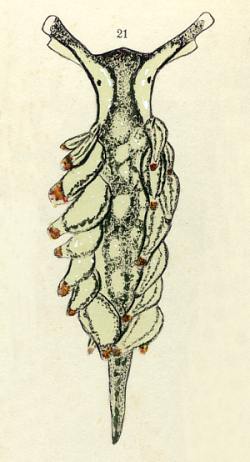
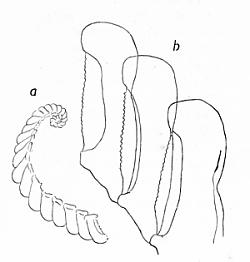
To accompany Kathe's comments on Aplysiopsis cf. formosa here are a couple of illlustrations from Pruvot-Fol's original description, as it is not easy to obtain.
ILLUSTRATIONS:
Aplysiopsis formosa: Upper: Plate 12, fig. 21. Lower: radula - Fig 14a,b. [Pruvot-Fol, 1953]
Although I don't have easy access to either Kathe's redescription (Jensen, 1995) or Ortea et al (1990), I do have a copy of Kerry Clark's (1982) description of A. zebra, which Kathe says is a synonym. Certainly the colour and shape, including the same green longitudinal bands down the sole of the foot appear identical in both the southern Australian and Atlantic animals, seem almost identical. The main difference is that Pruvot-Fol describes a reddish brown tip to the cerata of A. formosa. Clark illustrates a dark ceratal tip in A. zebra in his black & white drawing, but does not mention its colour in his description other than to say it was not reddish when comparing it with A. formosa. I can see no similar colour band at the tip of the southern Australian animals.
Another difference which may be important is that Clark describes the egg mass of A. zebra as "a non-adhesive string wound around the algae" (Cladophora prolifera), which is not how I would describe the egg mass of the southern Australian animals - see photo.
Clearly we need to examine the anatomy of this animal before it identity can be clarified.
References:
• Clark, K.B. 1982. A new Aplysiopsis (Opisthobranchia: Hermaeidae) from central Florida, with a brief summary of the ceratiform families of the order Ascoglossa (= Sacoglossa). Bulletin of marine Science, 32(1): 213-219.
• Jensen, K.R. 1995. Anatomy and biology of Aplysiopsis formosa Pruvot-Fol (Mollusca, Opisthobranchia, Sacoglossa) from the Azores. Acoreana, Suppl. 1995: 217-230.
• Pruvot-Fol, A. 1953. Etudes de quelques opisthobranches de la cote Atlantic du Maroc et du Senegal. Travaux de l'Institut Scientifique Cherifien, Zoologie, 5: 1-105.
• Ortea, J. Bacallado, J.J. & Sanchez, J.M.P. 1990. Aplysiopsis formosa Pruvot-Fol, 1953 (Mollusca, Opisthobranchia, Ascoglossa) in the Canary Islands. Lavori della Societa Italiana di Malacologia, Napoli, 23: 281-285.
Bill Rudman
Rudman, W.B., 2002 (Jul 22) Identity of Aplysiopsis cf. formosa. [Message in] Sea Slug Forum. Australian Museum, Sydney. Available from http://www.seaslugforum.net/find/7581Aplysiopsis cf. formosa from Victoria, Australia
July 15, 2002
From: Audrey Falconer
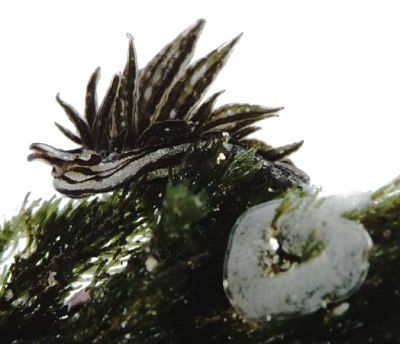
Dear Bill,
Concerning John Chuk's message about Aplysiopsis cf. formosa. I have seen this species in two locations in Victoria - at Point Lonsdale and at Portsea. Bob Burn has confirmed that these are indeed Aplysiopsis formosa. Here are some photos of it taken by my husband Leon Altoff.
Location: Between Portsea Pier and Point Franklin. Date: 9 February 2002
A snorkeller brought up an old, heavily encrusted snail Cabestana spengleri from shallow water (just over knee deep at low tide) with a clump of weed aproximately 5cm in diameter on the back. I picked a couple of slugs off the weed and then put all the weed in a vial so that I could count the slugs - in total there were 10 slugs and numerous egg "ribbons" (More like egg sausage-jellies) on the clump of weed. The slugs obviously got stressed in the vial and many of the cerata fell off - one was almost "naked"! The other photos show the slugs I took off the weed in the field and put in a separate vial to keep them good for photos, and there are closeups of an egg ribbon on the weed.
Audrey
audrey@bluering.org.au
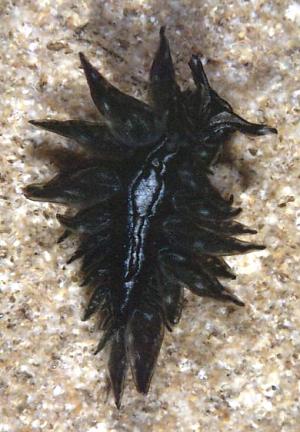
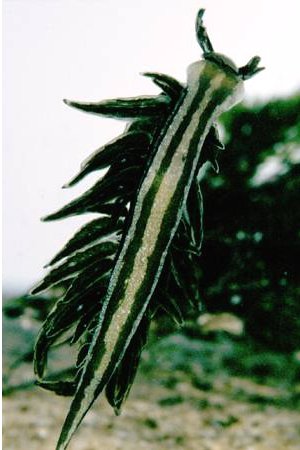
Thanks Audrey,
As we have seen with Sohgenia, sacoglossans are very like aeolids in their habit of dropping their cerata when stressed. [See Autotomy page]. I have posted your egg photos in a separate message.
Concerning the identity of this animal. Considering the situation we have with Placida dendritica and its apparent look-alikes worldwide, I think its best to call this animal Aplysiopsis cf. formosa until someone has a look at its anatomy. A. formosa was first described from Morocco and has since been reported from the Azores in the central Atlantic, and as A. zebra from the Caribbean. If these animals from southern Australia are indeed the same species, then the populations in either the Atlantic or southern Australia must have been established by artificial means.
Best wishes,
Bill Rudman
Egg ribbon of Aplysiopsis cf. formosa
July 15, 2002
From: Audrey Falconer
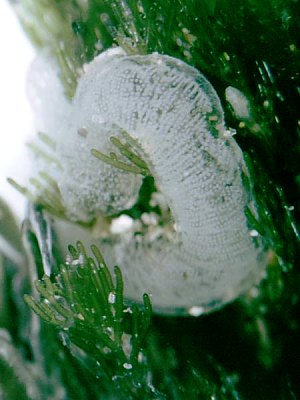
Dear Bill,
To accompany my other message here is a photo of the egg mass of Aplysiopsis cf. formosa.Attached please find 9 photos taken by my husband
Location: Between Portsea Pier and Point Franklin. 9 February 2002. Photo: Leon Altoff.
Audrey
audrey@bluering.org.au
Falconer, A., 2002 (Jul 15) Egg ribbon of Aplysiopsis cf. formosa. [Message in] Sea Slug Forum. Australian Museum, Sydney. Available from http://www.seaslugforum.net/find/7488Aplysiopsis formosa? from S.E. Australia
June 21, 2002
From: John Chuk

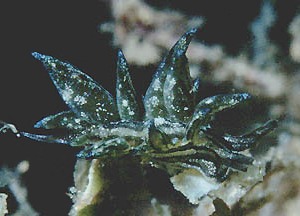
Dear Bill,
Here are two views of a specimen of what I think may be Aplysiopsis formosa. It was photographed on a dive at Flinders Pier, Victoria, Australia on 9th of April 2002. The specimen was 9mm in length and was found on the bottom beneath the pier at a depth of 3m.
I found it while closely observing a specimen of Rostanga calumus. I saw something move nearby, focussed on it, and found it was this sacoglossan. By patient searching I later found other specimens. I even photographed another specimen by accident, it just happened to be next to another slug I was photographing. I never saw it at the time, only noticed it on the slide later! I suspect it was present in large numbers but not obviously so due to the excellent camouflage. Your help with identification would be appreciated.
Best wishes,
John.
jchuk@giant.net.au
Chuk, J., 2002 (Jun 21) Aplysiopsis formosa? from S.E. Australia. [Message in] Sea Slug Forum. Australian Museum, Sydney. Available from http://www.seaslugforum.net/find/7191Dear John & Bill,
The pictures look like Aplysiopsis - which I have not described (as yet) from Australia. I did make a redescription of Aplysiopsis formosa Pruvot-Fol from the Azores, and I just looked in The Southern Synthesis (p. 973), where Bob Burn claims that he found that species from central Victoria. The animals on your pictures do look very similar - though I suspect they are rather small specimens?
The reference to my paper from the Azores is:
• Jensen, K.R. 1995. Anatomy and biology of Aplysiopsis formosa Pruvot-Fol (Mollusca, Opisthobranchia, Sacoglossa) from the Azores. Acoreana, Suppl. 1995:217-230.
Greetings,
Kathe Jensen
jensen@ait.ac.th
